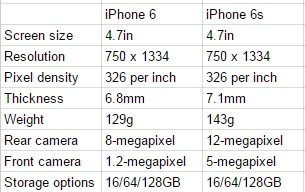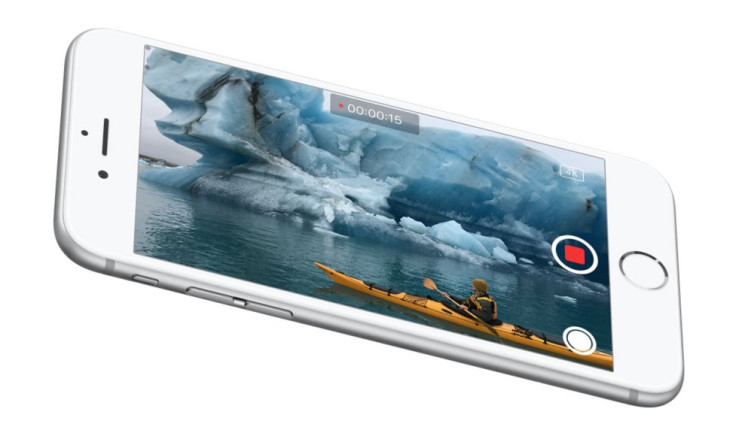What's the difference between iPhone 6 and iPhone 6S - and should I upgrade?
The biggest different between the iPhone 6 and new iPhone 6s is their screens.

Now that Apple has finally announced the iPhone 6s, answers to the big 'should I upgrade now or wait for another year?' question start to emerge. As is now tradition, the 'tock' of Apple's tick-tock update cycle sees the iPhone 6s retain the same design as its predecessor, but with some key upgrades.
iPhone 6s vs iPhone 6: The specifications

As you can see from the spec box on the right, on the surface very little has changed for the new iPhone 6s. But the 3D Touch technology is what really separates the two handsets. Apple has implemented 3D Touch into almost every aspect of iOS 9 – and feedback from the iPhone 6s' haptic engine (vibration motor) has been tuned to be more accurate.
It is disappointing to see Apple sticking with 16GB of storage for the base model of the iPhone 6s, when sure an increase to 32GB isn't too much to ask – especially since that is what you get from Samsung and Sony these days.
iPhone 6s vs iPhone 6: Display
The biggest different between the iPhone 6 and new iPhone 6s is their screens. They both measure 4.7in and have a resolution of 750 x 1334, but the major update here is 3D Touch. A development of Force Touch on the Apple Watch and newest MacBooks, 3D Touch knows how much pressure you are putting on the screen. This gives developers a whole new set of gestures to work and make their applications (and games) react to.
Apple has embedded 3D Touch deeply into the new iPhones' iOS 9 software, where it can be used to 'peak' at content such as the contents of message and links.
iPhone 6s vs iPhone 6: Design
As is usual for Apple's 's' upgrade the new iPhone is almost identical to the year-old iPhone 6. The only real change is the use of a stronger 7,000 series aluminium to reduce the risk of the phone bending when sat on in your pocket; this adds a fraction of a millimetre to the thickness of the handset (0.3mm to be precise, taking the iPhone 6s up to 7.1mm). Otherwise you will be hard-pressed to tell the difference between the two phones – good news for iPhone 6 owners not wanting to look out of date, bad news for any 6s buyers hoping to stand out.
Although the design is unchanged, Apple has introduced a new rose gold colour for the iPhone 6s and 6s Plus, which complements the equally new rose gold and regular gold Apple Watch Sport.

iPhone 6s vs iPhone 6: Camera
Another noticeable improvement is the new iPhone's camera. At 12MP it has a larger sensor than the 8MP iPhone 6, and Apple has worked hard to improve the way it uses every single one of those pixels. After explaining each improvement, Apple eventually resorted to assuring us that the 6s's camera is much better, and that's all we need to know.
A new software feature of the 's' phones is Live Photos, where the camera records a second of video before and after you take each photo, which can then be played to help bring an image to life. This feature isn't a million miles away from the animated photographs seen in the Harry Potter films.
As for video, the iPhone 6s and 6s Plus can now shoot 4K video – a first for any Apple handset. The front camera has also been improved, up from just 1.2MP on the iPhone 6 to a much more respectable 5MP on the iPhone 6s.
iPhone 6s vs iPhone 6: Processor and storage
Apple will have upset many by yet again failing to increase the minimum iPhone storage from 16GB to 32GB. The new iPhone 6s gets the same storage options as its year-old predecessor – 16GB, 64GB and 128GB. As has always been the case with iPhones, the new model does not include a microSD card slot to increase this. Apple will point to its iCloud online storage system as an alternative to storing files on the phone itself, but for areas of poor 4G coverage – or for customers with a low monthly data cap – this will not be seen as an adequate solution.
iPhone 6s vs iPhone 6: Price
The iPhone 6s is priced at £539 for the 16GB model, £619 for the 64GB model and £699 for the 128GB model. iPhone 6s Plus will be available for a suggested retail price of £619 for the 16GB model, £699 for the 64GB model and £789 for the 128GB model.
These are all broadly the same as the iPhone 6 and 6 Plus when they first went on sale a year ago.
© Copyright IBTimes 2025. All rights reserved.






















